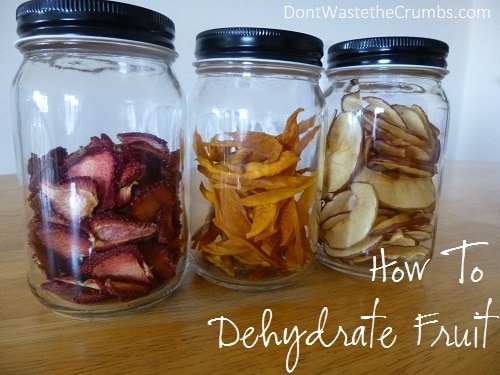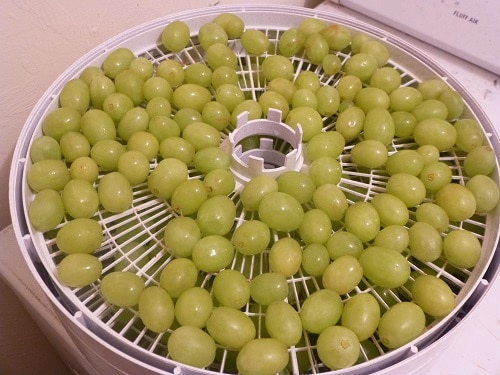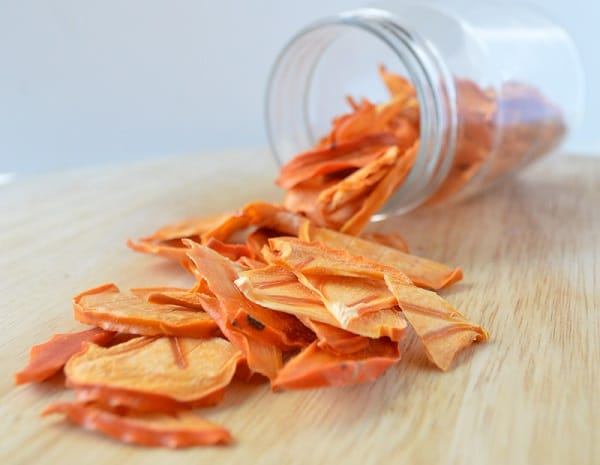HOW TO DEHYDRATE FRUIT
HOW TO DEHYDRATE FRUIT: BASIC FOOD PRESERVATION
Note: This is a very long post with instructions included within each individual fruit. This makes it easier if you’re looking for one in particular.
HOW TO DEHYDRATE GRAPES
Want to learn how to make raisins? Although I learned growing up that raisins were dried grapes, I don’t think I ever put two and two together until I made them myself! The 18 pounds of grapes from the produce bash provided an excellent, hands-on learning opportunity for everyone in the family.
We started with seedless green and seedless red grapes for experimentation. Both varieties turned out to be excellent for dehydrating. I imagine it’s possible to use seeded grapes as well, but you would definitely have to halve and remove the seeds first, before dehydrating.
- Wash the fruit thoroughly using an all natural produce wash. Drying is optional, since they’ll dry in the dehydrator anyway. Although working with dry fruit is easier and less messier than working with wet fruit.
- If the grapes have seeds, halve the grapes and remove the seeds. It is not necessary to slice whole, unseeded grapes.
- Lay the clean fruit on the dehydrator trays in a single layer. It’s okay if some of the fruit touches.
- Set the temperature to 135 degrees, the “fruit” setting on most dehydrators.
- Allow to dehydrate for 24-48 hours.
- Grapes are raisins when you squeeze them gently and there is very little “squish” left. Taste as you go since this may be a learned test of doneness.
- Yield: 2 pounds of grapes yields approximately two 16 oz glass jars of raisins, depending on the grapes used.
Tips:
- Periodically check on the fruit to see the speed at which they’re drying (every 6-8 hours). Smaller fruit will dry faster than larger fruit. They will also shrink in size as they dry, so you can combine trays and add in more fruit if you’d like.
- Water and juices will be released from the grapes as they dry, causing them to have a spot on the outside where the sweet, sticky juices are trying to escape. These juices made it a bit more important to shuffle every 8 hours if possible to prevent long-term sticking. This was more prevalent in the red grapes than the green grapes.
- Although they were the same size starting out, dried green raisins are noticeably larger than dried red raisins.
- When handed out to some friends for taste testing, comments such as “Wow, these are so much more flavorful than regular raisins” were common.
- You can jump start the dehydrating process by raising temperature to 145 degrees for the first 12 hours. After that, reduce it to 135 degrees to prevent burning or over-drying.
- I plan on keeping my raisins in jars and stored in the pantry for several months (so I don’t have to spend my grocery budget on dried cranberries). Because of this, I chose to keep the grapes in the dehydrator for close to 48 hours.
- If you have a hard time testing whether or not the fruit is “done,” turn off the dehydrator and let the fruit sit for 30 minutes to cool before tasting.
HOW TO DEHYDRATE BLUEBERRIES
Dehydrating blueberries provides a way to incorporate the fruit into fun snacks like granola bars or trail mix. If your blueberries are small to begin with, they will inevitably fall through larger holes in the trays. You can use the solid trays that come with dehydrators (often used for fruit rolls) to prevent escaping berries.
- Wash the fruit thoroughly using an all natural produce wash. Drying is optional, since they’ll dry in the dehydrator anyway. Although working with dry fruit is easier and less messier than working with wet fruit.
- Remove all the stems and lay the clean fruit on the dehydrator trays in a single layer. It’s okay if some of the fruit touches.
- Set the temperature to 115 degrees. The low temperature ensures the fruit doesn’t burn or char.
- Allow to dehydrate for 8-18 hours.
- Blueberries are done when you squeeze them and very little “squish” left. Taste as you go since this may be a learned test of doneness.
- Yield: a clamshell of blueberries (18oz) yields approximately one 8oz glass jars of dried blueberries.
Tips:
- Periodically check on the fruit to see the speed at which they’re drying (every 6-8 hours). Smaller fruit will dry faster than larger fruit. They will also shrink in size as they dry, so you can combine trays and add in more fruit if you’d like.
- If you have a hard time testing whether or not the fruit is “done,” turn off the dehydrator and let the fruit sit for 30 minutes to cool before tasting.
HOW TO DEHYDRATE STRAWBERRIES
Strawberries are another fun fruit to dehydrate – they’re SO easy to snack on!
- Wash the fruit thoroughly using an all natural produce wash. Drying is optional, since they’ll dry in the dehydrator anyway. Although working with dry fruit is easier and less messier than working with wet fruit.
- Remove the stems and cut the fruit in half. Laying the strawberries on their sides, cut into 3/8″ slices for thin strips, or 1/4″ for thicker strips. Lay the slices on the dehydrator trays in a single layer. End pieces should be laid with skin side down. It’s okay if some of the fruit touches.
- Set the temperature to 115 degrees. The low temperature ensures the fruit doesn’t burn or char.
- Allow to dehydrate for 8-18 hours.
- Strawberries are done when you squeeze them and very little “squish” left. Taste as you go since this may be a learned test of doneness.
- Yield: 1 pound of strawberries yields approximately one 16oz glass jars of dried strawberries.
Tips:
- Periodically check on the fruit to see the speed at which they’re drying (every 6-8 hours). Smaller fruit will dry faster than larger fruit. They will also shrink in size as they dry, so you can combine trays and add in more fruit if you’d like.
- If you have a hard time testing whether or not the fruit is “done,” turn off the dehydrator and let the fruit sit for 30 minutes to cool before tasting.
- If you want chunks instead of slices, dehydrate thicker slices of fruit and chop up with a sharp knife after the dehydrating process.
HOW TO DEHYDRATE PEACHES
Slices of dehydrated peaches are so much fun to gnaw on, even as an adult! Thick slices would be excellent for teething babies as they won’t break off easily. Like blueberries, dried peaches would also be great in granola bars or trail mix. Maybe some dried pineapple and coconut chunks too for a tropical variation!
- Wash the fruit thoroughly using an all natural produce wash. Drying is optional, since they’ll dry in the dehydrator anyway. Although working with dry fruit is easier and less messier than working with wet fruit.
- It is not necessary to remove the skin, you may if you’d like.
- Cut the peaches in half and remove the pits. Laying each peach with skin side up, cut into approximate 3/8″ slices for thick strips, or 1/4″ for thinner strips. Lay the slices on the dehydrator trays in a single layer. End pieces should be laid with skin side down. It’s okay if some of the fruit touches.
- Set the temperature to 135 degrees.
- Allow to dehydrate for 8-12 hours.
- Peaches are done when you squeeze them and very little “squish” left. Taste as you go since this may be a learned test of doneness.
- Yield: one large peach yields approximately half of one 8oz glass jars of dried peach slices.
Tips:
- Periodically check on the fruit to see the speed at which they’re drying (every 6-8 hours). Smaller slices will dry faster than larger fruit. They will also shrink in size as they dry, so you can combine trays and add in more grapes if you’d like.
- If you have a hard time testing whether or not the fruit is “done,” turn off the dehydrator and let the fruit sit for 30 minutes to cool before tasting.
- If you want chunks instead of slices, dehydrate thicker slices of fruit and chop up with a sharp knife after the dehydrating process.
HOW TO DEHYDRATE PERSIMMON
Fuyu persimmon are a bright orange fruit, naturally sweet and have the texture of a firm peach, or a soft apple. Avoid the Asian persimmon, as those are bitter and should be roasted first.
- Wash the fruit thoroughly using an all natural produce wash. Drying is optional, since they’ll dry in the dehydrator anyway. Although working with dry fruit is easier and less messier than working with wet fruit.
- It is not necessary to remove the skin.
- Cut the persimmon in half and lay each half on its side. Cut into approximate 3/8″ slices for thin strips, or 1/4″ for thicker strips. Lay the slices on the dehydrator trays in a single layer. It’s okay if some of the fruit touches.
- Set the temperature to 135 degrees.
- Allow to dehydrate for 8-12 hours.
- Persimmons are done when you squeeze them and very little “squish” left. Taste as you go since this may be a learned test of doneness.
- Yield: one large persimmon yields approximately half of one 8oz glass jars of dried persimmon slices.
Tips:
- Periodically check on the fruit to see the speed at which they’re drying (every 6-8 hours). Smaller slices will dry faster than larger fruit. They will also shrink in size as they dry, so you can combine trays and add in more fruit if you’d like.
- If you have a hard time testing whether or not the fruit is “done,” turn off the dehydrator and let the fruit sit for 30 minutes to cool before tasting.
- If you want chunks instead of slices, dehydrate thicker slices of fruit and chop up with a sharp knife after the dehydrating process.
HOW TO DEHYDRATE PINEAPPLE
Pineapples are naturally sweet and when dehydrated, the sweet becomes richer and deeper, making an absolutely delicious snack!
- Cut the tops and bottom off a fresh pineapple. Stand the pineapple on its end and carefully cut the outer skin off, leaving just the yellow flesh.
- Cut the pineapple into quarters from top to bottom. Remove 1/2″ of core from each quarter.
- Laying each quarter on its side, slice the pineapple into 3/8″ slices for thin strips, or 1/4″ for thicker strips. Lay the slices on the dehydrator trays in a single layer. It’s okay if some of the fruit touches.
- Set the temperature to 135 degrees.
- Allow to dehydrate for 12-18 hours.
- Pineapples are done when you squeeze them and very little “squish” left. Taste as you go since this may be a learned test of doneness.
- Yield: one large pineapple yields approximately two of 8oz glass jars of dried pineapple slices.
Tips:
- Periodically check on the fruit to see the speed at which they’re drying (every 6-8 hours). Smaller slices will dry faster than larger fruit. They will also shrink in size as they dry, so you can combine trays and add in more fruit if you’d like.
- If you have a hard time testing whether or not the fruit is “done,” turn off the dehydrator and let the fruit sit for 30 minutes to cool before tasting.
- If you want chunks instead of slices, dehydrate thicker slices of fruit and chop up with a sharp knife after the dehydrating process.
HOW TO DEHYDRATE MANGO
Mangos tied with peaches for which fruit was the most fun to chew on – my son chose mangos and my daughter chose peaches! The mangos are in the far left of the above picture. (Strawberries are in the middle and apples on the right. We kept those jars on the kitchen table for easy snacking and it was PERFECT.)
- Hold the mango so that the oblong shape is vertical (points at the top and bottom). Cut off one side of the mango approximately 1/2″ from the center. Repeat with the other side.
- Cut each half into thirds, for one long strip and two boat-shaped end pieces. Lay the fruit skin side down and using a sharp, non-serrated knife, carefully filet the flesh from the skin. Cut off any smaller remaining pieces of flesh from the skin and reserve for smoothies or snacks.
- Slice the flesh of the skin into 3/8″ slices for thin strips, or 1/4″ for thick strips. Lay the slices on the dehydrator trays in a single layer. End pieces should be laid with skin side down. It’s okay if some of the fruit touches.
- Set the temperature to 135 degrees.
- Allow to dehydrate for 8-12 hours.
- Mangoes are done when you squeeze them and very little “squish” left. Taste as you go since this may be a learned test of doneness.
- Yield: one large mango yields approximately half of one 8oz glass jars of dried mango slices.
Tips:
- Periodically check on the fruit to see the speed at which they’re drying (every 6-8 hours). Smaller slices will dry faster than larger fruit. They will also shrink in size as they dry, so you can combine trays and add in more fruit if you’d like.
- If you have a hard time testing whether or not the fruit is “done,” turn off the dehydrator and let the fruit sit for 30 minutes to cool before tasting.
- If you want chunks instead of slices, dehydrate thicker slices of fruit and chop up with a sharp knife after the dehydrating process.










Comments
Post a Comment